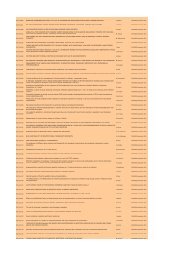Profilaksa DVT kod velikih ortopedskih operacija - Depol ...
Profilaksa DVT kod velikih ortopedskih operacija - Depol ...
Profilaksa DVT kod velikih ortopedskih operacija - Depol ...
You also want an ePaper? Increase the reach of your titles
YUMPU automatically turns print PDFs into web optimized ePapers that Google loves.
20 - 22 September 2012, Opatija, Croatia<br />
OSTEOPOROSIS: COMMON FEATURE UNDERLINED BY<br />
DIFFERENT PATHOGENETIC MECHANISMS<br />
Danka Grčević, University of Zagreb School of Medicine, Zagreb, Croatia<br />
The misbalance in the differentiation and activity of principal bone cells, bone forming osteoblasts and bone<br />
resorbing osteoclasts, leads to osteoporosis, characterized by the loss of bone mass and increased risk of fragility<br />
fractures. There are multiple pathogenetic mechanisms underlying osteoporosis, involving not only the osteoblastic<br />
and osteoclastic cell lineages but also other bone-marrow cells, systemic hormones, local cytokines,<br />
and growth factors. The RANKL/RANK interaction is critical for osteoclastogenesis and hence represents a final<br />
common pathway for any pathogenetic factor in osteoporosis that acts by increasing osteoresorption. By using<br />
different mouse models, we investigated several aspects of the disease mechanism, addressing both bone formation<br />
and bone degradation. We used genetic mutation causing the osteogenesis imperfecta murine (OIM),<br />
to confirm that the osteoblastic lineage is under continuous stimulation, but with decreased ability for maturation.<br />
Moreover, immature osteoblasts strongly support osteoclastogenesis, through higher RANKL/OPG ratio and<br />
TNF-alpha expression. In view of the reports that human postmenopausal osteoblasts constitutively express Fas<br />
and our finding that Fas receptor activation directly inhibits osteoblast differentiation, we confirmed that Fas/FasL<br />
system has an important role in the pathogenesis of postmenopausal osteoporosis by mediating apoptosis and<br />
inhibiting differentiation of osteoblast lineage cells. Inflammatory processes alter the bone microenvironment to<br />
promote irreversible bone destruction. In pathologic states, activated T-lymphocytes produce RANKL and other<br />
proresorptive cytokines playing a role in osteoporosis as well as inflammation-induced bone loss. In the model of<br />
systemic inflammation, by endotoxin administration, and autoimmune reaction, in collagen-induced arthritis, we<br />
confirmed that there is a decrease in total bone mass mediated by increased number of identified bone-marrow<br />
and peripheral osteoclast progenitors and their enhanced activity maintained by proinflammatory factors. Finally,<br />
we hypothesize that cells expressing smooth muscle alpha-actin promoter (aSMA)-directed transgene represent<br />
mesenchymal progenitors of adult bone tissue and confirmed that aSMA+ cells serve as a pool of skeletal progenitors<br />
with a potential for terminal differentiation into mature osteoblasts during fracture healing. Although<br />
we identified a defined population of mesenchymal progenitors with the active role in bone regeneration, many<br />
puzzles are still missing before we would be able to achieve the full therapeutic success in osteoporosis treatment.<br />
Oral<br />
45




